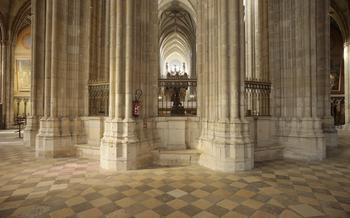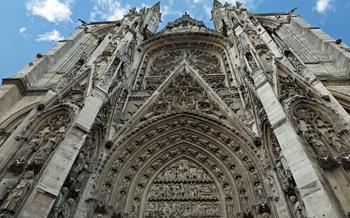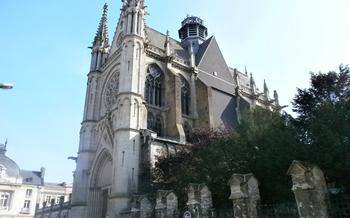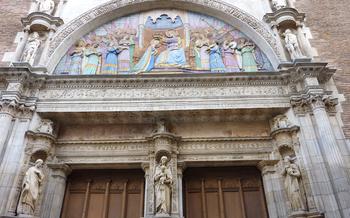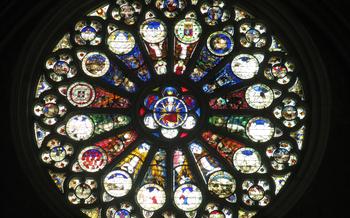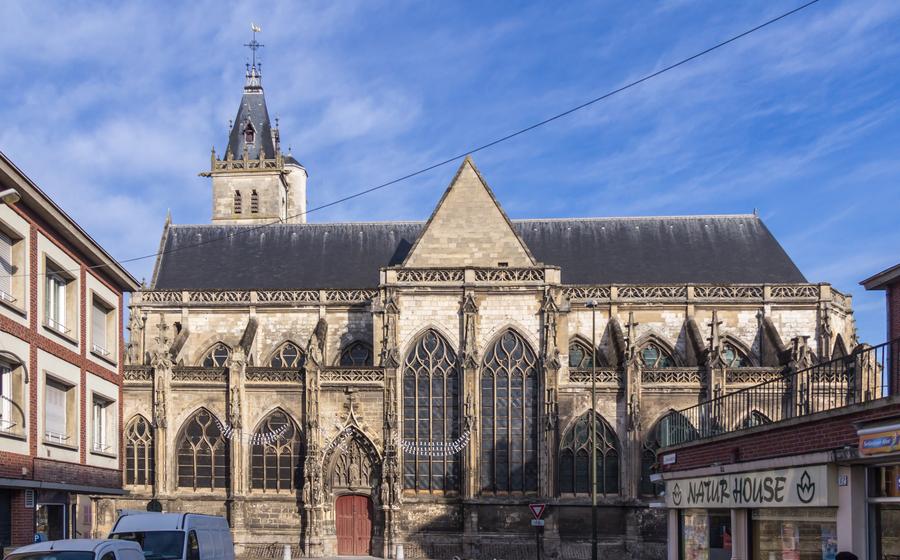
Église Saint Germain l'Écossais
- History of the Église Saint Germain l'Écossais
- Location of the Église Saint Germain l'Écossais
- Visiting Hours of the Église Saint Germain l'Écossais
- Admission Fees of the Église Saint Germain l'Écossais
- Highlights of the Église Saint Germain l'Écossais
- Église Saint Germain l'Écossais's Architectural Details
- Église Saint Germain l'Écossais's Artwork and Decorations
- Église Saint Germain l'Écossais's Historical Significance
- Église Saint Germain l'Écossais's Role in the Community
- Tips for Visiting the Église Saint Germain l'Écossais
- Église Saint Germain l'Écossais's Place in Amiens's Religious Landscape
- Église Saint Germain l'Écossais's Historical Significance Compared to Other Churches in Amiens
- Insider Tip: Unveiling the Hidden Beauty of the Église Saint Germain l'Écossais
History of the Église Saint Germain l'Écossais
The Église Saint Germain l'Écossais is a Gothic masterpiece located in the heart of Amiens, France. Its foundation dates back to the 12th century when a Scottish Benedictine monastery was established on the site. The church was built over several centuries, with the oldest parts dating from the 13th century. Over time, the church underwent several modifications and expansions, blending architectural styles from different periods. The most significant changes occurred in the 16th century when the Gothic choir was rebuilt in the Flamboyant style, adding ornate decorations and intricate vaults.
Architectural Style
The Église Saint Germain l'Écossais is a prime example of Gothic architecture, characterized by its pointed arches, ribbed vaults, and flying buttresses. The exterior boasts intricate carvings, gargoyles, and statues that adorn the facade and buttresses, showcasing the skill and artistry of medieval craftsmen. The interior is equally impressive, with its soaring nave, delicate stained-glass windows, and ornate altars that create a breathtaking and awe-inspiring ambiance.
Changes Over Time
Throughout its history, the Église Saint Germain l'Écossais has witnessed numerous changes and renovations. In the 17th century, the church was partially damaged during the Fronde, a series of civil wars in France. The subsequent restoration work led to the addition of Baroque elements, such as the elaborate pulpit and the richly decorated side chapels. In the 19th century, the church underwent a major restoration campaign under the direction of the renowned architect Eugène Viollet-le-Duc, who restored the building to its original Gothic splendor.
Religious Significance
The Église Saint Germain l'Écossais holds deep religious significance for the local community. It has served as a place of worship for centuries, hosting regular masses, baptisms, and other religious ceremonies. The church is dedicated to Saint Germain, a 5th-century bishop of Auxerre, who is revered for his piety, scholarship, and miracles. His relics are enshrined in the church, attracting pilgrims and devotees from across the region.
Location of the Église Saint Germain l'Écossais
The Église Saint Germain l'Écossais is situated in the heart of Amiens, a captivating city in northern France. Its exact address is Rue Saint Germain, 80000 Amiens, placing it within easy reach of other prominent attractions. The church stands proudly in the historic city center, making it accessible on foot or by bicycle. Visitors can immerse themselves in the charm of Amiens' cobbled streets as they make their way to this architectural gem.
For those arriving by public transportation, the Église Saint Germain l'Écossais is conveniently located near several bus stops. The "Saint Germain" stop, served by lines L1, L6, and L7, is just a short walk away. Alternatively, the "Cathédrale" stop, serviced by lines L1, L2, and L3, is also within walking distance. These bus routes connect the church to various parts of Amiens, ensuring seamless accessibility.
Visiting Hours of the Église Saint Germain l'Écossais
The Église Saint Germain l'Écossais welcomes visitors with open doors during specific hours. To ensure a fulfilling and respectful visit, it's essential to be aware of its operating schedule.
The church is generally open to the public from 9:00 AM to 7:00 PM on weekdays, providing ample time to explore its awe-inspiring interiors. However, it's worth noting that these hours may vary depending on special events, religious services, or holidays.
For those seeking a more immersive experience, guided tours are available upon request. These tours, led by knowledgeable guides, offer a deeper insight into the church's rich history, architectural intricacies, and captivating artwork. Guided tours are an excellent way to learn about the significance of this sacred space and appreciate its beauty from an informed perspective.
While the church is closed on major holidays such as Christmas and Easter, it remains open on most other holidays, allowing visitors to experience its serene atmosphere and admire its architectural grandeur. It's always advisable to check the official website or contact the church directly for any updates or changes in the visiting hours to avoid disappointment.
Admission Fees of the Église Saint Germain l'Écossais
Visiting the Église Saint Germain l'Écossais is free of charge for all visitors. This open-door policy reflects the church's commitment to welcoming people from all backgrounds, regardless of their financial means or religious beliefs. The church encourages everyone to explore its sacred space, admire its architectural beauty, and find moments of peace and reflection within its walls.
While admission is free, donations are gratefully accepted to support the ongoing maintenance and preservation of this historic building. Visitors can contribute to the church's upkeep by leaving a donation in the collection boxes located inside the church or by contacting the parish directly. By doing so, they not only contribute to the preservation of this cultural and religious heritage but also show their appreciation for the welcoming and spiritual environment that the church provides.
Highlights of the Église Saint Germain l'Écossais
The Église Saint Germain l'Écossais is a true architectural gem that boasts a myriad of notable features. Its exterior facade is adorned with intricate carvings and sculptures, showcasing biblical scenes and figures with remarkable detail. Inside, visitors are greeted by a breathtaking display of stained glass windows, each narrating a different biblical story with vibrant colors and exquisite craftsmanship. These windows, dating back to the 13th century, are considered among the finest examples of Gothic stained glass art in France.
The church's interior is further embellished with stunning murals, paintings, and sculptures, each contributing to its rich artistic tapestry. Among the notable artworks, visitors can admire the 16th-century altarpiece depicting scenes from the life of Saint Germain, as well as the 18th-century pulpit adorned with intricate carvings. The church also houses several historical artifacts and relics, including the relics of Saint Germain, which are believed to possess miraculous powers.
One unique characteristic that sets this church apart is its dual dedication. It is dedicated to both Saint Germain, the patron saint of shepherds, and the Scottish community that once resided in Amiens. This dual dedication is reflected in the church's artwork and symbolism, which incorporates elements from both French and Scottish cultures.
Église Saint Germain l'Écossais's Architectural Details
The Église Saint Germain l'Écossais displays a remarkable blend of architectural styles, showcasing elements of both Romanesque and Gothic architecture. Its exterior design is characterized by a striking facade featuring intricately carved portals and a magnificent rose window. The interior layout is spacious and well-lit, with a nave flanked by elegant side chapels. The construction materials primarily comprise limestone and brick, lending a warm and inviting ambiance to the space. The church's symbolic and hidden meanings are revealed through its intricate carvings, decorative elements, and stained glass windows, which depict scenes from the Bible and the lives of saints.
Église Saint Germain l'Écossais's Artwork and Decorations
The Église Saint Germain l'Écossais is adorned with a stunning array of artwork and decorations that reflect the artistic sensibilities of different eras. The church's stained glass windows, created between the 13th and 16th centuries, are a particular highlight. These vibrant masterpieces depict scenes from the Bible and the lives of saints, casting a kaleidoscope of colors onto the interior.
The church also boasts a collection of murals, paintings, and sculptures that showcase the skill of medieval and Renaissance artisans. Notable works include the 15th-century mural of the Last Judgment, which depicts the separation of the saved and the damned, and the 16th-century painting of the Entombment of Christ, attributed to the Flemish artist Jan Provost.
In addition to these major works of art, the church is adorned with intricate carvings, moldings, and tapestries. These decorative elements add to the overall beauty and grandeur of the interior, creating a sense of awe and reverence.
The Église Saint Germain l'Écossais is a true treasure trove of religious art and decoration. Visitors can spend hours admiring the intricate details and symbolism of these works, gaining a deeper appreciation for the artistic heritage of Amiens and the Catholic Church.
Église Saint Germain l'Écossais's Historical Significance
The Église Saint Germain l'Écossais holds a significant place in the religious and historical landscape of Amiens. It has witnessed numerous pivotal events and played a crucial role in shaping the city's spiritual and cultural heritage.
This magnificent edifice served as a place of worship for the Scottish community residing in Amiens during the Middle Ages. The presence of a Scottish community in the city dates back to the 13th century when King David I of Scotland established close ties with the French monarchy. As a result, many Scottish merchants and soldiers settled in Amiens, contributing to the city's commercial and military prowess.
The Église Saint Germain l'Écossais stands as a testament to the enduring relationship between France and Scotland. It has served as a spiritual haven for generations of Scottish immigrants, providing them with a sense of community and belonging in a foreign land.
Furthermore, the church has been intricately linked to several historical figures. In the 15th century, it was visited by Joan of Arc, the legendary French heroine who led the French army to victory against the English during the Hundred Years' War. Joan of Arc's visit to the church highlights its significance as a place of pilgrimage and devotion.
The Église Saint Germain l'Écossais has also played a crucial role in the civic life of Amiens. It has hosted numerous religious ceremonies, festivals, and gatherings, serving as a focal point for the community. Over the centuries, the church has witnessed countless baptisms, weddings, and funerals, becoming an integral part of the lives of its parishioners.
Today, the church continues to be an active place of worship, attracting both locals and visitors alike. It remains a symbol of Amiens's rich history and cultural diversity, showcasing the city's deep-rooted connections to Scotland and its enduring spiritual legacy.
Église Saint Germain l'Écossais's Role in the Community
The Église Saint Germain l'Écossais plays an integral role in the community, extending its influence beyond its sacred walls. The church serves as a spiritual hub, hosting regular religious services and ceremonies, where parishioners gather to celebrate and worship. Its role in the community is further strengthened through its involvement in various outreach programs and initiatives. These programs aim to support the local community, fostering a sense of belonging and solidarity among its members.
The church actively participates in educational and cultural endeavors. It organizes events, workshops, and seminars to promote religious knowledge, art, and history. These initiatives provide opportunities for the community to engage with the church's rich heritage and explore the spiritual and cultural dimensions of life. Collaborations with local organizations, such as schools, libraries, and community groups, further enhance the church's involvement in the wider community, creating a sense of unity and shared purpose.
Tips for Visiting the Église Saint Germain l'Écossais
When visiting the Église Saint Germain l'Écossais, it is important to be respectful of the religious nature of the site. Visitors should dress appropriately, avoiding shorts, tank tops, or other revealing clothing. Photography is allowed inside the church, but it is important to be mindful of other visitors and avoid using flash or taking photos during religious services. It is also important to be aware of the church's operating hours and plan your visit accordingly. Guided tours are available, and it is recommended to book in advance to ensure a spot.
Combining the visit to the Église Saint Germain l'Écossais with other nearby attractions can make for a fulfilling day of exploration. The church is located in the heart of Amiens's historic center, within walking distance of many other notable landmarks, such as the Amiens Cathedral, the Hortillonnages floating gardens, and the Musée de Picardie. Visitors can easily spend a day exploring the city's rich history and culture, and the Église Saint Germain l'Écossais is a must-see for anyone interested in religious architecture, art, and history.
Église Saint Germain l'Écossais's Place in Amiens's Religious Landscape
The Église Saint Germain l'Écossais has a unique place in Amiens's religious landscape. While the city is predominantly Catholic, this church stands as a testament to the diversity and tolerance that have characterized Amiens throughout its history. The church has maintained a strong relationship with the local Catholic community, often collaborating on religious events and initiatives. Despite its Protestant roots, the Église Saint Germain l'Écossais has become a symbol of unity and understanding among different faiths in Amiens.
The church's commitment to ecumenism and interfaith dialogue is evident in its active participation in various religious and cultural events. It regularly hosts ecumenical services, bringing together members of different Christian denominations to pray and worship together. The church also collaborates with local Muslim and Jewish communities to promote interfaith understanding and cooperation. Through these initiatives, the Église Saint Germain l'Écossais plays a vital role in fostering a harmonious and inclusive religious environment in Amiens.
Église Saint Germain l'Écossais's Historical Significance Compared to Other Churches in Amiens
Compared to other churches in Amiens, the Église Saint Germain l'Écossais holds a unique place in the city's historical narrative. While other churches, such as the Cathédrale Notre-Dame d'Amiens, may be more prominent or well-known, Saint Germain l'Écossais has played a distinct role in shaping the religious and cultural landscape of Amiens.
Its foundation as a royal abbey in the 12th century gave it a close connection to the monarchy, and throughout history, it has been associated with significant historical events and figures. For example, it served as a refuge for Scottish Benedictine monks fleeing religious persecution in their homeland, lending it a unique international dimension.
Furthermore, the church's strategic location near the city walls and the Somme River made it a crucial site during times of conflict. During the Hundred Years' War, it served as a military stronghold, and its sturdy construction helped it withstand numerous attacks and sieges.
In the centuries that followed, the Église Saint Germain l'Écossais continued to be a place of religious significance, hosting important ceremonies and events. It also became a repository of cultural heritage, housing valuable artworks, relics, and artifacts that tell the story of Amiens's rich past.
Today, while other churches in Amiens may attract more visitors due to their grandeur or fame, the Église Saint Germain l'Écossais remains a hidden gem, offering a glimpse into the city's lesser-known history and providing a unique perspective on its religious and cultural heritage.
Insider Tip: Unveiling the Hidden Beauty of the Église Saint Germain l'Écossais
In the heart of Amiens, nestled amidst the bustling cityscape, lies a hidden gem awaiting discovery within the confines of the Église Saint Germain l'Écossais. As you stand in awe before its grand facade, take a moment to venture beyond the main entrance and seek out the secluded courtyard that lies concealed within. Here, amidst the tranquil embrace of nature, you will uncover a hidden oasis that offers a unique perspective of the church's architectural splendor.
In this serene sanctuary, time seems to stand still as the soft glow of sunlight illuminates the intricate details of the church's exterior. The delicate carvings that adorn the facade come alive, casting intricate shadows that dance upon the cobblestone floor. From this vantage point, you can fully appreciate the harmonious blend of Gothic and Renaissance elements that define the church's architectural style.
As you gaze upon the Église Saint Germain l'Écossais from this secluded haven, let your imagination soar and transport you back in time. Picture the devout pilgrims who once sought solace within these sacred walls, the whispered prayers that echoed through the centuries, and the grand ceremonies that unfolded under the watchful gaze of the towering spires.
Whether you seek a moment of tranquility, a deeper connection to the church's history, or simply a breathtaking view, the hidden courtyard of the Église Saint Germain l'Écossais offers an experience that is both enchanting and unforgettable. Embrace the opportunity to discover this secret treasure and let the magic of Amiens unfold before your eyes.
